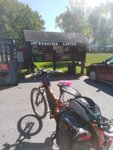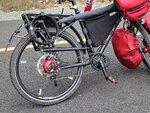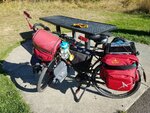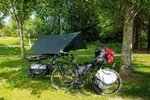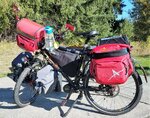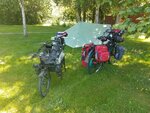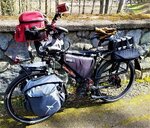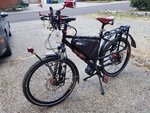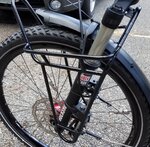For me it depends.
This year my girlfriend and I traveld from Switzerland/German border through Switzerland to the South of France and some way around. Including mountains, but no trails.
Girlfriend wanted a holiday, not just riding every day and every our, but time was limited.
so we took two Speed Pedelec that I equipped with BionX D-motors and 13s8p batteries in the frame bag. Built my battery with 5 year old Panasonic PF cells (ca. 1080Wh) and my girlfriends battery with LG MJ1 cells (ca. 1310Wh). On normal roads we road around 30-45km/h, on steep ascents slower and in sightseeing places often much slower (incl pushing).
Range is around 150km for me and around 200km for my girlfriends setup. I didn't expect that she actually consumes less battery power than I did, being smaller and more lightweight more than compensates for having less leg power if you ride fast, I assume.
The small license plate is removable (magnetic holder). Speed pedelecs are no problem in Germany and especially Switzerland, but I wasn't sure about France. Turned out that they are more or less unknown there, but we didn't encounter any problems...
Bikes weight around 22-23kg with the large battery. In a more lightweight configuration for everyday use (carbon seatpost instead of Thudbuster, more lightweight saddle, more lightweight pedals, standard BionX 13s4p battery, no bottle holder) they do weight around 20kg. Lighter would be better, but the options are very limited.
Bionx motors are risky. if the motors fail you have no options to repair them on the road, neither will you find any bike shop that can. You could let a friend send you a spare motor+wheel to a destination, which should work quite okay within EU for me. Outside the EU I would chose another system. I had spare BionX parts for all the rest, battery electroni, display, etc... but didn't need them
We used a Cycle Satiator for each bike to recharge. I planed to charge during midday rest at restaurant but it turned out that we didn't travel that way. We started late in the day and didn't eat in restaurants until we arrived in the evening. So almost all charging took place over night. A charger without fan is very important on crowded camping places imho.
Battery almost finished. Weights ca. 5.3kg
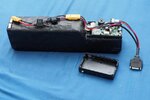
Bikes based on Diamant supreme+ s-Pedelec from 2011:
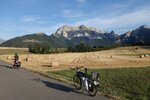
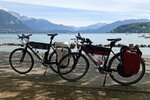
Tour statistics for some part of the trip. I was mainly interested in the amount of regeneration using Spped Pedelecs on Tour. Used a Junsi Powerlog 6s for data logging

This is for riding a bike mostly on road in Europe, mainly using camping sites to recharge and using train or cars to transport the bike
If you make a trip further away crossing continents I would use something different.
From my bikes I would probably chose the Dahon Flo, which weights around 13kg without rack, lights and fenders and without a motor drive. I'm not sure if it would be wise to chose a motor drive for such a long tour. Travalling with Lithium battery by plane of ferry can turn out very problematic and maintaining a luggage weight incl electric bike below 30kg seems to be very difficult. For many designs the e-bike alone would weight that much.
Dahon Flo "folding" MTB, not my picture:
https://img.ricardostatic.ch/t_1800x1350/pl/1082502210/0/2/
Maybe I would try to equip the Dahon Flo with a 2kg geared hub drive rear motor and maybe two sub 100Wh batteries. Sadly the GRIN LiGo are not able to charge quickly. I would prefer to charge them with the Satiator or similar at 300W or more. Maybe it would be possible to build such batteries lets say on the Sony VTC5A cell. As a 10s1p battery this would be 36V and 2,6Ah and below the 100W limit. with good cooling charging at 5A should be doable, so two of them in parallel could work.
The Dahon Flo equipped with such a setup and proper touring outfit could weight maybe 18kg. Spare parts tools and charger included maybe you could keep it at 20kg.
Obviously with only 190Wh available it would reduce the electric drive to moderate uphill assist only and you need to plan with charging opportunities during the day. At 8A you should be able to charge 36V*4Ah = 144Wh within a rest of 30 minutes, IF you can find an outlet.
Maybe solar charging would be an option to.
I read everything I could find on solar ebikes and already have all the stuff sitting around (Tout Terrain Mule trailer, 50W solar panels with sunpower cells, Genasun chargers) but I lack the trip to use that stuff. Bike + trailer + solar is not something that travels easily by train, not even thinking about planes. Maybe for a trip to North or North East Europe in one of the next summers...
A theoretical option could be NiMh batteries. There are no flight restrictions on those. Lightweight it isn't.
For bike parts I try to keep it simple.
3x 9 gearing works fine for all of my bikes. Work well with 9x or 10x chains. If you have a problem you still have a 3x or 9x gearing system until you fix it. Chains are easy to repair.
For traveling outside the "1st world" I prefer mechanical brakes over hydraulic ones, but so far my hydraulik brakes didn't have any problems while touring. Had one leaking after an accident at home and one didn't wok well from the beginning until I replaced it. If they work well hydraulic brakes usually are the better brakes, but good is good enough for me.
On normal roads I do not need complex suspension. For the Speed pedelecs above I added a Redshift stem and a Thudbuster seatpost which both give slight suspension via elastomers. This has been good enough for our needs. On heavy terrain a suspension fork and thick tires are better abiously, but the supension fork is just another part that can fail.
I don't care much about aluminium vs steel vs carbon. I''m not so heavy and my gear isn't either, so so far I do not brake my frames or forks. I'm aslo not willing to spend more than 3000€ on a electric biccyle and this is after all modifications.
I like the Tubus logo racks (sadly the titanium version which weights less is not available any more) and usually try to keep my stuff in just two rear panniers
My 2ct
